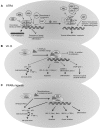Differentiation therapy of leukemia: 3 decades of development
- PMID: 19221035
- PMCID: PMC2943835
- DOI: 10.1182/blood-2009-01-198911
Differentiation therapy of leukemia: 3 decades of development
Abstract
A characteristic feature of leukemia cells is a blockade of differentiation at a distinct stage in cellular maturation. In the 1970s and 1980s, studies demonstrating the capabilities of certain chemicals to induce differentiation of hematopoietic cell lines fostered the concept of treating leukemia by forcing malignant cells to undergo terminal differentiation instead of killing them through cytotoxicity. The first promising reports on this notion prompted a review article on this subject by us 25 years ago. In this review, we revisit this interesting field of study and report the progress achieved in the course of nearly 3 decades. The best proof of principle for differentiation therapy has been the treatment of acute promyelocytic leukemia with all-trans retinoic acid. Attempts to emulate this success with other nuclear hormone ligands such as vitamin D compounds and PPARgamma agonists or different classes of substances such as hematopoietic cytokines or compounds affecting the epigenetic landscape have not been successful on a broad scale. However, a multitude of studies demonstrating partial progress and improvements and, finally, the new powerful possibilities of forward and reverse engineering of differentiation pathways by manipulation of transcription factors support the continued enthusiasm for differentiation therapy of leukemia in the future.
Figures



References
-
- Sachs L. Control of normal cell differentiation and the phenotypic reversion of malignancy in myeloid leukaemia. Nature. 1978;274:535–539. - PubMed
-
- Breitman TR, Collins SJ, Keene BR. Terminal differentiation of human promyelocytic leukemic cells in primary culture in response to retinoic acid. Blood. 1981;57:1000–1004. - PubMed
-
- Koeffler HP. Induction of differentiation of human acute myelogenous leukemia cells: therapeutic implications. Blood. 1983;62:709–721. - PubMed
Publication types
MeSH terms
Substances
LinkOut - more resources
Full Text Sources
Other Literature Sources

